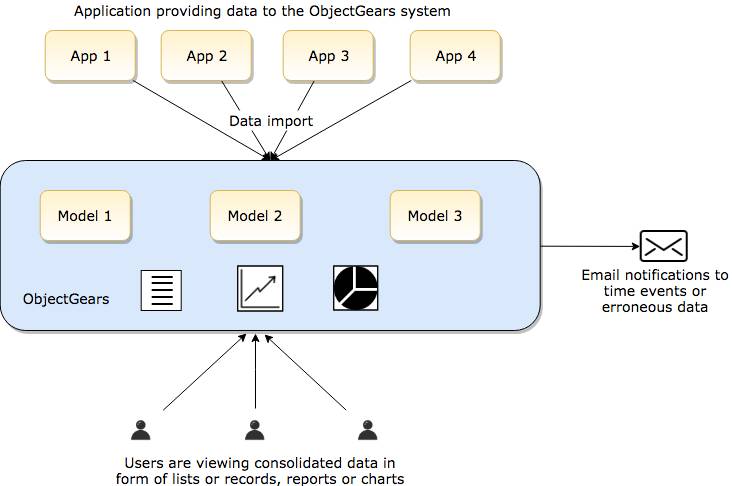Why do we need interconnected data
13.10.2018
Today IT in every company operates with various number of applications. From several few up to hundreds and thousands. Each application processes its own information and in most cases it passes the information further to other applications. Interconnected data mean possibility of a fast realization of new requirements. However, is this matter of course?
Many applications pass data between themselves but there are many other necessary data interchanges that are not realized.

Scheme 1: Solid line represents an existing data interchange between applications. Dashed line represents requested data interchange that is not realized.
Need to share data and its solution is a challenge for all IT teams. Why applications often do not share data?
There can be several reasons:
1) Application did not count with it and therefore, it is not able to share the data.
2) The given need for data interchange interchange does not relate to critical processes and nobody wants to invest into the interface.
3) Vendor/developer of the application is not available any more or source files were lost.
4) Application is developed externally and the vendor does not want to implement the interface just for us..
5) ...and many other reasons.
By interconnecting data we mean sharing information between applications with a goal to utilize them as much as possible.
Concept of the ObjectGears system comes with connecting data as one of elementary advantages of the whole system. Applications are in ObjectGears segmented into models (which are independent units). You can have an unlimited number of models in one ObjectGears instance.
By means of a simple activation of a source class with information from one model to another model you can easily create a column referring to a source class. You can fast create as much connections like this as you need.
Therefore, you do not need neither imports, nor exports within one instance. Everything is available immediately online.

Scheme 2: Interconnected data
Source data cannot be deleted because they are referrenced - the system ensures data integrity. In contrast to that when connecting two applications by exports/imports anybody can delete whatever data without taking consequent relations into account which destroys data integrity.

Scheme 3: When deleting a record in Application 1 the user is not informed about relations. The change will be propagated to Application 2 only later - with delay of couple of minutes, hours or days.

Scheme 4: When deleting a record in the source model also database table record is deleted. There is a database relation on it (foreign key), which does not allow deletion, if there is a relation from the target model.
By means of queries or another functionality (e.g. function Reference to user) you can see where the source information is used which is a very interesting benefit.
E.g. when a user is leaving the company, you can easily find out, where he or she is stated as an owner, what he or she has lent, which tasks he should be handed over, where he or she provides training or ´where they are registered.
HR then do not search whether the user fulfilled everything what he or she had to do, because they can see everything in the ObjectGears system. Optionally, the user can look himself/herself and arrange for everything proactively without taking up time of many other people.
These do not need to be only users. If you use in your organization work items like cars, measuring devices or cameras then you can easily find out on which project they used them, when a maintenance is scheduled, who and when wants to lend them etc.
In case this information is scattered across systems, it is necessary to manually go through them and check. And this costs time and money. Therefore, quite often nobody does that and this issue is solved only when more serious problems arise.
OG as an aggregator
How would you like this functionality? Nothing is less easier. Install ObjectGears system in the company. You can easily import data from current applications into ObjectGears and create new applications and functions.

Scheme 5: Applications send data to the ObjectGears system, that present them to the users in form of a list of records, reports or charts. At the same time it sends emails with information about new records or errors in data. The benefit is the ability to work with the data further.
You add another functionality to such acquired data that might not be possible in the original applications.
E.g.
- e-mail notifications for approaching deadlines
- highlight erroneous or suspicious records + inform about them with email notifications
- display reports, charts and overviews
- assign tasks to users
- add new fields to data for additional information
- start workflow based on data
There are many possibilities. However, essential is quick access to information. ObjectGears system supports all that natively, also in the FREE version (up to 25 users).